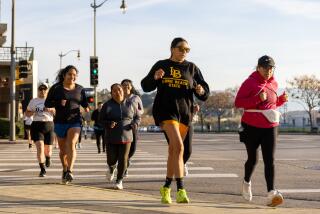Group Runs Toward Goal of Fighting Cancer Among High-Risk Blacks
Antonia Routt, a 43-year-old recreational runner, got up before her running mates as they sat on the bleachers of the Jackie Robinson Stadium in Southwest Los Angeles to make a special request.
Routt’s voice shook as she asked the members of the Renaissance Runners, a group of about 150 African Americans, to participate in a race in honor of one of the club’s members who is undergoing chemotherapy for breast cancer.
“It’s one thing to run in memory” of someone, she said. “It’s a beautiful thing to say, ‘I am walking in honor of someone we love, a person who is here.’ ”
For 16 years, the Renaissance Runners have tried to combat the high incidence of cancer in the black community by organizing the annual Minnie Riperton 5K/10K Run and Walk, co-sponsored by the American Cancer Society’s central Los Angeles unit. This year’s race will be held Sunday.
The Renaissance Runners say the Minnie Riperton run, named after the rhythm and blues singer who died from cancer at age 31 in 1979, is their way of calling attention to statistics indicating that blacks are about 15% more likely to develop cancer than people of other races. Cancer is the second-leading cause of death among African Americans.
The group was formed 20 years ago by 13 people. Since then, more than half a dozen club members have died from cancer, including the club’s first president and co-founder, George Wilkes, according to member Welton Jones, who has a relative undergoing chemotherapy.
According to a 1994 American Cancer Society study, 454 out of every 100,000 blacks are likely to develop cancer, compared with 394 of every 100,000 whites. Research conducted by the National Cancer Institute has suggested that the disparity can be linked to inadequate access to care, lower education and poverty among African Americans.
“We feel it right here in our club and in our community,” said Joe Patten, 60, a cancer survivor who is running his usual 25 miles a week only three weeks after surgery.
That’s why the race has remained in South-Central Los Angeles, beginning and ending at the Coliseum and following a route primarily on Martin Luther King Jr. Boulevard.
But organizers have begun to worry that their race will not survive. With an average attendance of 1,200 and an average profit of $50,000, it is often overshadowed by more popular fund-raisers, such as Making Strides Against Breast Cancer, that are backed by the American Cancer Society’s regional and state units. This year, Making Strides had 9,000 participants and raised $700,000.
Organizers fear that the American Cancer Society, which only backs races that raise more than they cost, will drop its sponsorship.
“We’re just hoping that it can survive the brunt of all the larger events. We don’t have the glitz and the glamour,” said Yumiko Carr, the event manager for the society’s central Los Angeles unit.
Charles Green, media specialist at the American Cancer Society/Los Angeles County Regional Unit, said organizers of the Riperton race have “definitely proven themselves.”
Race organizers are hoping to gain more corporate sponsors and increase attendance to keep the race alive.
“We’re not dwindling yet,” runner Jones said.
More to Read
Go beyond the scoreboard
Get the latest on L.A.'s teams in the daily Sports Report newsletter.
You may occasionally receive promotional content from the Los Angeles Times.










